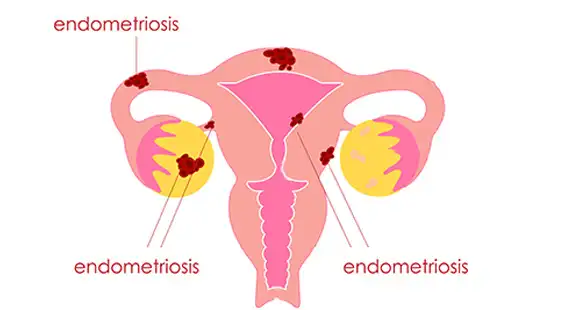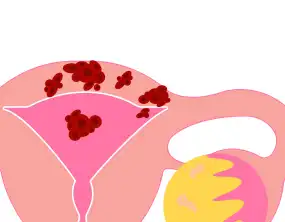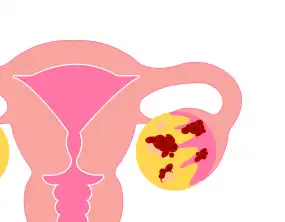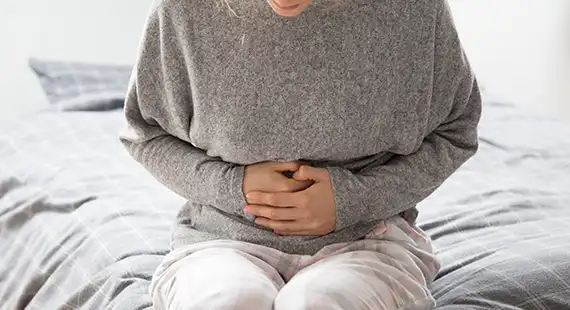Endometriosis: Meaning, Symptoms, Causes & Treatment
Endometriosis is a gynaecological condition in which there is an extra growth of endometrial cells in the external regions of the uterus, ovaries and fallopian tube. This occurs most commonly in reproductive-aged women in their 20s. Endometrial cell growth can also occur in ovaries leading to endometrial lesions, which are referred to as pseudocysts or ovarian endometriomas.

WHAT IS ENDOMETRIOSIS
Endometriosis is a medical condition where the tissue that normally lines the inside of the uterus grows outside of it, typically on other reproductive organs like the ovaries, fallopian tubes, or on the lining of the pelvis. These tissue growths can cause inflammation, pain, and the formation of scar tissue that can interfere with the normal functioning of organs in the abdominal cavity.
Endometriosis can cause severe pelvic pain, painful menstrual periods, painful intercourse, and infertility. Treatment options for endometriosis can include pain management, hormonal therapy, or surgery, depending on the severity of the symptoms and the individual needs of the patient.

TYPES OF ENDOMETRIOSIS
Superficial endometriosis
The least severe type of endometriosis wherein endometrial tissue is attached to the peritoneum.
1

Endometriomas
Type of endometriosis that is most common in ovaries and may appear in various pelvic regions.
2

Deep-infiltrating endometriosis
A rare type of endometriosis wherein the endometrial tissue invades the organs like rectum, bladder, bowels, and ovaries.
3

CAUSES
- Peritoneal cell transformation
- Embryonic cells transformed into endometrial cells
- Surgical scar implantation- post-C-section and hysterectomy can cause endometriosis.
- Menstruation blood flowing back towards fallopian tubes
- Due to some immune disorders
SYMPTOMS
- Excessive menstrual bleeding
- Infertility
- Dysuria- Extreme pain while peeing
- Dyschezia- Extreme pain while pooping
- Dyspareunia- Extreme pain in the genitals during sex
- Dysmenorrhea - Extreme pain in pelvis during periods

DIAGNOSIS
Diagnosing endometrisois include:
- Asking about medical history of the patient, previous pregnancies, or the family members having endometriosis.
- Physical examination of the pelvic region
- Ultrasound to get more information from pelvic images
- MRI to further assess endometrial tissues
- Laparascopy to confirm the diagnosis of endometriosis
DO's
DONT's
TREATMENTS
Non- Surgical Treatment

Pharmacological therapy
- Hormonal agents - Gonadotropin-releasing hormone analog like danazol is used to alleviate the symptoms arising due to endometriosis.
- Anti-inflammatory drugs - To reduce pain and inflammation drugs like progestins are prescribed.
SURGICAL TREATMENTS

- Laparoscopic surgery- It is better than pharmacological agents because they maintain fertility capability. This surgical procedure involves excising out all the extra growing cells near the uterus, fallopian tube outside the ovaries and other endometriotic lesions. It helps in decreasing the inflammation in the pelvic region.
- Cystectomy- This surgical procedure involves removing complete cysts formed during endometriosis. It helps in relieving pain and decreases the recurrence ratio.
- Hysterectomy-This surgical procedure involves removing the inflamed uterus or ovaries.
Risk and Complications
- Infertility
- Subfertility
- Chronic pelvic pain
- Dysmenorrhea
- Dyspareunia
- Bladder dysfunction

IF LEFT UNTREATED
If you are ignoring endometriosis and do not want any treatment for this condition, it may get worse. It can lead to infertility or problems in conceiving. The endometrial cells can grow to other parts of the pelvic region around the uterus, ovaries, and fallopian tubes.
COST
The average cost of laparoscopic hysterectomy to treat adenomyosis is ₹35,000 - ₹40,000. The cost varies from the type of surgical procedure, hospital facilities and cities.
Financial Options

INSURANCE COVERAGE
Insurance coverage for endometriosis treatment may vary depending on the individual insurance plan, the specific treatment being considered, and the severity of the condition. In general, insurance providers may cover treatments that are deemed medically necessary, such as medications or surgeries, if other less invasive treatments have failed to alleviate symptoms.
However, insurance coverage for endometriosis treatments may also be subject to certain restrictions or requirements. For example, insurance plans may require that certain diagnostic tests or procedures be performed before approving coverage for a particular treatment. Additionally, insurance providers may limit coverage for certain treatments based on factors such as age, medical history, or the specific symptoms experienced.

Know more about Endometriosis
The exact cause of endometriosis is not known, but several theories exist. One theory suggests that endometrial tissue may travel through the fallopian tubes and implant outside the uterus. Another theory suggests that endometrial tissue may grow in other parts of the body due to hormonal imbalances or immune system dysfunction.
There is no cure for endometriosis, but with appropriate treatment, most women are able to manage their symptoms and maintain their quality of life. Women with endometriosis may also benefit from lifestyle changes such as regular exercise, a healthy diet, and stress reduction techniques.
It is important for women with symptoms of endometriosis to seek medical attention, as early diagnosis and treatment can help prevent complications and improve outcomes. Women with endometriosis may also benefit from support groups or counseling to manage the emotional and psychological impact of the condition.
 New Delhi
New Delhi  Bangalore
Bangalore  Mumbai
Mumbai  Hyderabad
Hyderabad  Pune
Pune  Chennai
Chennai 
